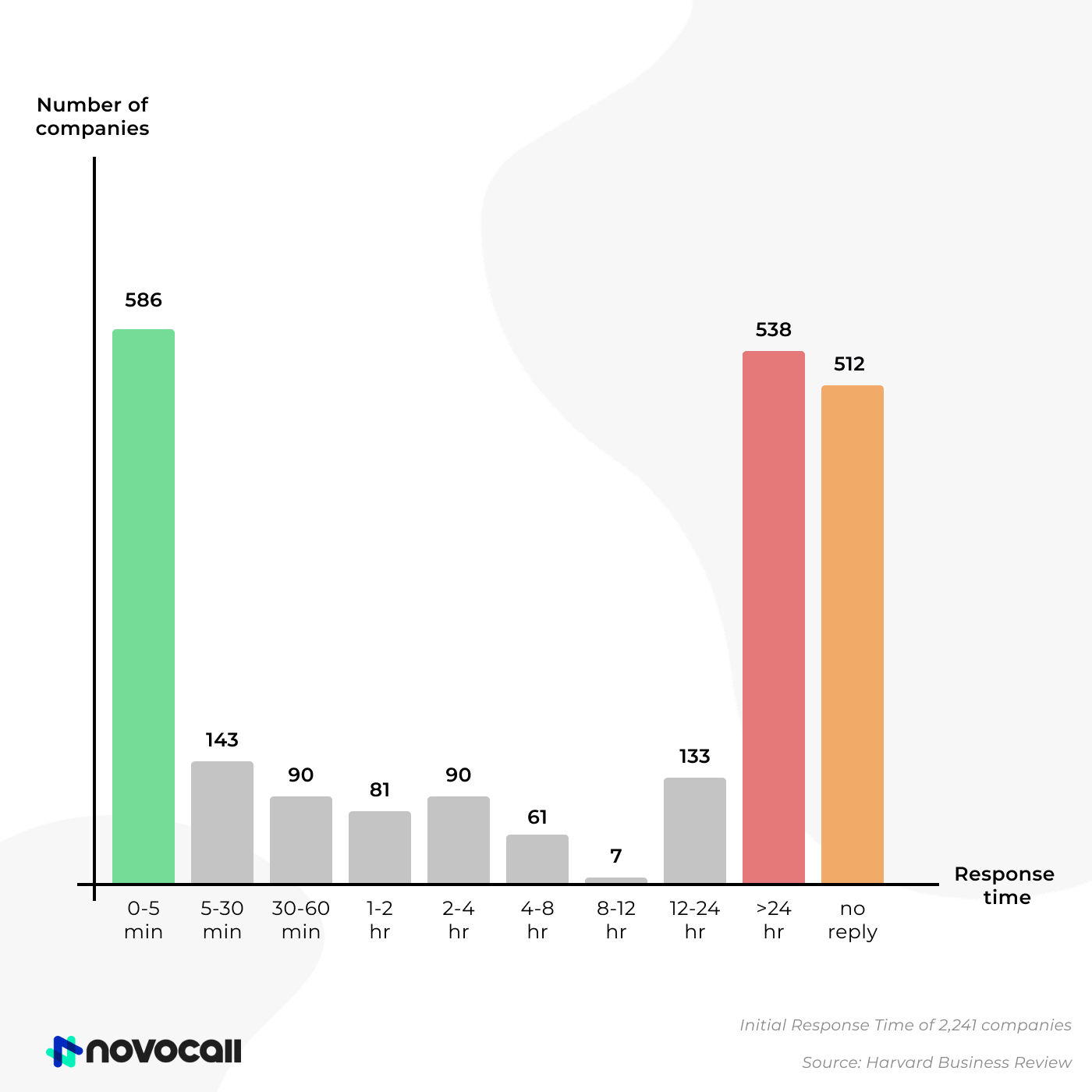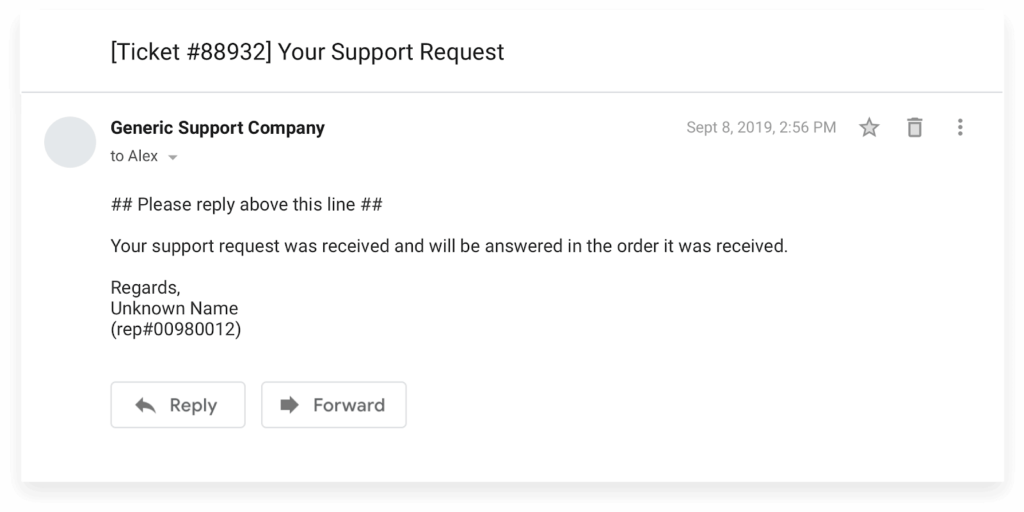

Start driving better conversations.
Novocall will be your new favorite business phone system.

A recent 2018 study found that 58% of companies don’t follow-up with their leads. Shocker.
Although 8 years have passed since the infamous Harvard Business Review lead response study, it seems like little progress has been made. Back in 2010, the average lead response time was 42 hours.
It seems like people have yet to fully understand what lead response time really means and why it’s important.
That’s what we’re here to do. Let’s clarify any doubts regarding lead response time once and for all and reiterate its importance.
Lead response time is the length of time it takes for businesses to follow up with leads after they’ve been contacted by the prospects from either inbound and outbound channels.

Unfortunately, businesses underestimate the value and power of responding quickly. Arguably the most cited study on this topic was done by Harvard Business Review. The study involved a total of 2,241 companies and revealed that 24 % of companies took over 24 hours to respond while 23 % didn’t respond at all.
If you take that long to respond to your leads, it’s no wonder that they’ve already sought out your competitors before you even know it.
Let’s dive deeper into why you should pay attention to lead response time.
Lead response time is important because leads that are coming from your outbound marketing channels, already cost you money in the first place.
According to eMarketer, B2B companies will spend $9.03 billion on digital ads in 2021, up 35.9% from 2019. And your company may very well be one of them.
For example, let’s say your business tries to generate leads using Facebook lead ads and pays around $500 per week to generate leads.
But what if your team took so long to respond to the leads generated from the ads that they’ve gone to your competitors by the time you eventually reach out? That’s $500 worth of ad spend wasted!
The investment that you already spend into gaining those leads is useless unless you try to close them. And definitely, not following up on those leads will be wasted on your investment.
Okay, maybe the average cost you spend on inbound leads could be 61% less than outbound leads. But research by Gleanster stated that 50% of leads you got from your inbound channel are most likely qualified leads and 25% are most likely ready to convert.
A similar study from InsideSales.com (now XANT) shows that 35–50% of sales will most likely deal with the company that responds first to their inquiry. So, decreasing lead response times can help fill the company’s pipeline with more sales opportunities.
It is important to pay attention to lead response time when executing your inbound lead generation strategy as most of these are potential leads and customers.
You’re so close to closing a deal. Why would you make them wait?
Lead response time is important because it helps the company create a better experience. By responding to leads in less than 5 minutes, reduce the amount of frustration they experience when waiting for a rep from your team to respond to them.
And as a business, creating a better customer experience and customer satisfaction is important. Because 70% of the buying experience is dependent on how the prospects are being treated.
It’s easy to calculate lead response time.
All you need is data on three things. The time in which your leads contacted you, the time in which your team responded to them, as well as the total number of leads. These will be used to calculate the time taken to report to that particular lead.


Once you’ve gotten that value, calculate the sum of all the lead response times you’ve obtained and divide it by the number of contacts or leads to obtain the average lead response time.
Even though 62% of customers prefer phone calls, you still can’t forget about the rest of the 38% who prefer other methods of communication!
So, how else can you reach out to your customers in the quickest time possible?
Yup, through live chat software like LiveChat. The software offers real-time service online, meaning that your customers can get immediate information and support from your reps whenever they drop you a message via a chat window.
In fact, live chatting has a 92% consumer satisfaction rate, and 63% of visitors who used live chat on a website are likely to return to that website.
That’s because live chatting serves as a way to initiate the first point of contact, especially when your site visitors are the most interested.
To take this to the next level, you can also leverage a lead generation chatbot. This would help you automate the entire process of communicating with the leads and would allow your customer support reps to deal with more complex queries from the leads.
So, not only are your site visitors getting fast responses, but they’re also more satisfied with your business. Killing two birds with one stone! 💪
We all know the pain of scheduling a call with a sales rep all too well.
You go through endless back-and-forth emails just to schedule a single call. Combine this with the amount of time needed for your sales reps to see an email request for a call and respond to that email, and you end up with leads who wait for an eternity before they can interact with your company.
Unacceptable 🙅♀️🙅♂️
Here’s where click-to-call software comes in. As its name suggests, a lead literally clicks a button and receives a call from your rep.
And just like that, you can reach out to your leads in under 30 seconds.
If you are unavailable at the current moment, Novocall’s click-to-call software also allows you to schedule automated callbacks. And because the software is integrated with Google and Outlook calendars, both the sales rep and the lead will receive a reminder from their calendar apps before the meetings.

This way, leads receive an immediate update on the time a call will take place just by selecting a time slot.
Emails and calls aren’t the only ways for your sales teams to respond to leads. Messaging apps are quite frequently used by leads to communicate with businesses as well!
The problem is when different leads and customers use different messaging apps to communicate with the business. This can make it very difficult for businesses to manage the conversations they have with them.
Lead response time inevitably suffers as businesses are too busy trying to manage existing conversations to quickly respond to new ones 😩

Chat marketing platforms such as NovoChat are integrated with several messaging apps. NovoChat allows businesses to manage all their WhatsApp Business, Telegram, Messenger, and LINE conversations via a centralized inbox.
You can monitor all chat messages with your leads and respond to them promptly. This makes it easier for your sales teams to reply to your leads faster and they do not waste time filtering through countless conversations.
If you’re still manually assigning leads to your sales reps, please stop 🛑
Not only will you take a long time to assign all your leads to your sales reps, but you may also even end up assigning them to the wrong reps.
That’s where automated lead distribution software come in.
Novocall allows you to set predetermined distribution criteria. These include sales rep availability, business function, geographic location, and language. Leads who schedule calls via Novocall are then automatically assigned to the right sales rep.

Leads will no longer have to wait for long periods of time, only to get matched to the wrong rep. And because the process is automated leads who schedule calls with your team will not need to wait long for a call appointment to be confirmed. They will receive the notification within 30 seconds.
Okay, so you don’t intend to have live chat software and your team is too small to have a dedicated rep to answer calls?
Fret not! You can still reduce lead response times with SuperOffice‘s email automation feature.
For example, when a site visitor decides to contact you for a product demo or submits a support ticket, you can immediately send them an automated email response to acknowledge that their email has been received and that your rep will contact them shortly.

Even though this doesn’t exactly mean that you’re chatting with the customer in real-time, you don’t leave the customer wondering if their email got through or if it’s just sitting in your junk mail.
This also buys your reps some time to prepare for the product demo and any questions the lead has.
A study by Lead Response Management revealed that businesses that respond to leads in less than 5 minutes are 100x more likely to connect with a lead than businesses that take over an hour.
Meanwhile, businesses that respond in less than 5 minutes are 21x more likely to convert a lead than those who take over an hour to reply.
While most of the study recommends responding in less than 5 minutes. I think we can agree that ensuring leads receive an update to their query is even better!
Lead generation tools like Novocall’s click-to-call allow for that! Once leads have filled in lead forms, they select a time slot for a callback to be automated between themselves and the sales rep of the company.
The lead will immediately be notified that a call has been scheduled and booked in their Google or Outlook calendars. When the time for the call has arrived, Novocall will automate a call to connect the lead and the assigned sales rep.
As you can see lead response time is a very important metric you should start measuring ASAP.
Not only can it help you save costs, but also drive conversion and ultimately, sales.
I hope we’ve been able to help you gain a deeper understanding of what lead response time really is. To receive more sales and marketing content, subscribe to our blog below 👇👇👇

Faye is a digital marketing executive at Novocall. When she’s not busy writing articles for Novocall’s blog, she spends her time baking and playing with her dogs.
Discover more
Subscribe to our blog
Get insights & actionable advice read by thousands of professionals every week.

